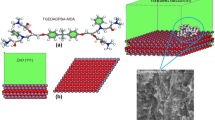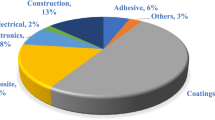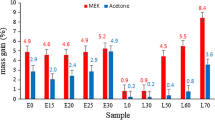Abstract
Epoxy resin, diglycidyl ether of bisphenol A (DGEBA) and triethylenetetramine (TETA), is known to be hygroscopic in nature, which eventually leads to mechanical performance degradation of the material. The long-standing debate on the nature of water-epoxy interaction has been investigated in this study with the help of terahertz spectroscopy, which is able to probe sub 100 cm− 1 wavenumbers in which hydrogen bonds of water are active as well as infrared spectroscopy, which is able to probe 600–1000 cm− 1 in which the libration motions of the water molecules are dominant. Based on observations, it can be demonstrated that both hydrogen-bonded water (with epoxy) and free interstitial water (hydrogen-bonded with itself) is present when the epoxy resin is exposed to normal or saline water. A schematic diagram is presented to demonstrate epoxy-water interactions.








Similar content being viewed by others
References
M.I.B. Tavares, J. D’almeida, S. Monteiro, Journal of applied polymer science 78(13), 2358 (2000).
F.G. Garcia, B.G. Soares, V.J. Pita, R. Sánchez, J. Rieumont, Journal of Applied Polymer Science 106(3), 2047 (2007).
C.A. Wood, W.L. Bradley, Composites science and Technology 57(8), 1033 (1997).
L.R. Xu, A. Krishnan, H. Ning, U. Vaidya, Composites Part B: Engineering 43(5), 2480 (2012).
A. Siriruk, D. Penumadu, Y.J. Weitsman, Composites Science and Technology 69(6), 821 (2009).
K. Imielińska, L. Guillaumat, Composites Science and Technology 64(13-14), 2271 (2004).
L.H. Strait, M.L. Karasek, M.F. Amateau, Journal of composite materials 26(14), 2118 (1992).
A. Siriruk, D. Penumadu, Composites Part B: Engineering 61, 94 (2014).
B. Wei, H. Cao, S. Song, Corrosion Science 53(1), 426 (2011).
P. Suma Sindhu, D. Ghindani, N. Mitra, S.S. Prabhu, Journal of Adhesion Science and Technology 34(20), 2262 (2020).
P. Moy, F. Karasz, Polymer Engineering & Science 20(4), 315 (1980).
L. Jelinski, J. Dumais, A. Cholli, T. Ellis, F. Karasz, Macromolecules 18(6), 1091 (1985).
M. Woo, M.R. Piggott, Journal of Composites, Technology and Research 9(3), 101 (1987).
M. Antoon, J. Koenig, T. Serafini, Journal of Polymer Science: Polymer Physics Edition 19(10), 1567 (1981).
J. Zhou, J.P. Lucas, Polymer 40(20), 5505 (1999).
L. Thrane, R.H. Jacobsen, P.U. Jepsen, S. Keiding, Chemical Physics Letters 240(4), 330 (1995).
C. Rønne, P.O. Åstrand, S.R. Keiding, Physical review letters 82(14), 2888 (1999).
D. Prasad, N. Mitra, S. Bandyopadhyay, The Journal of Physical Chemistry B 123(30), 6529 (2019).
D.M. Carey, G.M. Korenowski, The Journal of chemical physics 108(7), 2669 (1998).
G. Walrafen, The Journal of Chemical Physics 40(11), 3249 (1964).
S. Krishnamurthy, R. Bansil, J. Wiafe-Akenten, The Journal of Chemical Physics 79(12), 5863 (1983).
J. Hasted, S. Husain, F. Frescura, J. Birch, Chemical Physics Letters 118(6), 622 (1985).
M.A. González, J.L. Abascal, The Journal of chemical physics 135(22), 224516 (2011).
C. Jördens, S. Wietzke, M. Scheller, M. Koch, Polymer Testing 29(2), 209 (2010).
K. Krügener, S. Sommer, E. Stübling, R. Jachim, M. Koch, W. Viöl, Journal of Infrared, Millimeter, and Terahertz Waves pp. 1–5 (2019).
M. Selver, M. Secmen, E. Zoral, in: Journal of Physics: Conference Series, vol. 1141 (IOP Publishing, 2018), vol. 1141, p. 012151.
P.S. Sindhu, D. Prasad, S. Peli, N. Mitra, P. Datta, Journal of Molecular Structure 1184, 114 (2019).
A. Apicella, L. Nicolais, C. De Cataldis, in: Characterization of polymers in the solid state I: Part A: NMR and other spectroscopic methods Part B: mechanical methods (Springer, 1985), pp. 189–207.
Acknowledgements
Authors would like to acknowledge the laboratory facilities at Photonics lab, Tata Institute of Fundamental Research, Mumbai, and Center for Research Facilities at Indian Institute of Technology Kharagpur, India.
Author information
Authors and Affiliations
Corresponding author
Ethics declarations
Conflict of Interest
The authors declare no competing interests.
Additional information
Publisher’s Note
Springer Nature remains neutral with regard to jurisdictional claims in published maps and institutional affiliations.
Electronic supplementary material
Below is the link to the electronic supplementary material.
Rights and permissions
About this article
Cite this article
Sindhu, P.S., Mitra, N., Ghindani, D. et al. Epoxy Resin (DGEBA/TETA) Exposed to Water: a Spectroscopic Investigation to Determine Water-Epoxy Interactions. J Infrared Milli Terahz Waves 42, 558–571 (2021). https://doi.org/10.1007/s10762-021-00788-5
Received:
Accepted:
Published:
Issue Date:
DOI: https://doi.org/10.1007/s10762-021-00788-5




